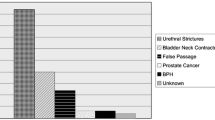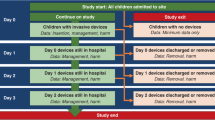Abstract
Background
Tubes and catheters are frequently used in the care of hospitalized children. Yet little is known about errors in diagnosis in commonly implanted devices in a pediatric population.
Objective
The purpose of this study was to determine the frequency and range of diagnostic errors with inserted devices in a pediatric population.
Materials and methods
During a 9-year period 142,041 cases were reviewed as part of our ongoing quality-assurance process. Of 4,084 disagreements in diagnosis encountered, 50 cases with diagnostic errors related to endovascular catheters, gastrointestinal, genitourinary and neurosurgical tubes, and pacemaker wires were identified and retrospectively reviewed. Diagnostic error was defined as a diagnosis that was unintentionally delayed, wrong or missed. These errors were classified as perceptual, cognitive, system-related or unavoidable and were graded according to potential clinical impact using a scale from 1 to 4, with 4 being the most serious.
Results
Device-related diagnostic errors accounted for 1.2% of all discrepancies identified and 10% of errors potentially leading to a change in therapy. Seventeen of the 50 diagnostic errors were related to vascular catheters (34%), including wrong anatomical location of catheter tip (12) and missed catheter fracture or migration (5). Twenty-seven errors (54%) were related to non-vascular catheters and involved enteric tube location (15), ventricular drainage catheters (7), endotracheal tubes (3) and genitourinary catheters (2). Six additional errors involved a vascular stent, endovascular cuff, needle, chest tube and epicardial wire placement (2).
Conclusion
Device-related diagnostic errors are not frequent in complex pediatric patients. However, they can have a clinically significant impact on patient outcomes and management. High-risk situations include altered patient anatomy, poor or limited image quality, inconspicuous lines and incomplete review of prior studies.

















Similar content being viewed by others
References
Teele SA, Emani SM, Thiagarajan RR et al (2008) Catheters, wires, tubes and drains on postoperative radiographs of pediatric cardiac patients: the whys and wherefores. Pediatr Radiol 38:1041–1053
Hunter TB, Taljanovic MS, Tsau PH et al (2004) Medical devices of the chest. Radiographics 24:1725–1746
Taylor GA, Voss SD, Melvin PR et al (2011) Diagnostic errors in pediatric radiology. Pediatr Radiol 41:327–334
Graber ML, Franklin N, Gordon R (2005) Diagnostic error in internal medicine. Arch Intern Med 165:1493–1499
VA National Center for Patient Safety. The basics of failure mode and effect analysis. Available at www.patientsafety.gov/SafetyTopics.html. Accessed 6 July 2006
Bagian JP, Gosbee J, Lee CZ et al (2002) The veterans affairs root cause analysis system in action. Jt Comm J Qual Improv 28:531–545
Benavidez OJ, Gauvreau K, Jenkins KJ et al (2008) Diagnostic errors in pediatric echocardiography: development of taxonomy and identification of risk factors. Circulation 117:2995–3001
Kassirer JP, Kopelman RI (1989) Cognitive errors in diagnosis: instantiation, classification, and consequences. Am J Med 86:433–441
Bordage G (1999) Why did I miss the diagnosis? Some cognitive explanations and educational implications. Acad Med 74:S138–S143
McGee DC, Gould MK (2003) Preventing complications of central venous catheterization. N Engl J Med 348:1123–1133
Fitzgerald R (2001) Error in radiology. Clin Radiol 56:938–946
Brenner RJ, Lucey LL, Smith JJ et al (1998) Radiology and medical malpractice claims: a report of the practice standards claims survey of the Physician Insurers Association of America and the American College of Radiology. AJR 171:19–22
Renfrew DL, Franken EA, Berbaum KS et al (1992) Error in radiology: classification and lessons in 182 cases presented at a problem case conference. Radiology 183:145–150
Berbaum KS, Franken EA Jr, Dorfman DD et al (1992) Satisfaction of search in diagnostic radiology. Invest Radiol 27:571–573
Samuel S, Kundel HL, Nodine CF et al (1995) Mechanism of satisfaction of search: eye position recordings in the reading of chest radiographs. Radiology 194:895–902
Berbaum KS, Franken EA, Dorfman DD et al (2000) Role of faulty decision making in the satisfaction of search effect in chest radiography. Acad Radiol 7:1098–1106
Espinosa JA, Nolan TW (2000) Reducing errors made by emergency physicians in interpreting radiographs: longitudinal study. Br Med J 320:737–740
Acknowledgment
The authors wish to express their thanks to Mrs. Jane Choura for expert manuscript editing.
Author information
Authors and Affiliations
Corresponding author
Rights and permissions
About this article
Cite this article
Fuentealba, I., Taylor, G.A. Diagnostic errors with inserted tubes, lines and catheters in children. Pediatr Radiol 42, 1305–1315 (2012). https://doi.org/10.1007/s00247-012-2462-7
Received:
Revised:
Accepted:
Published:
Issue Date:
DOI: https://doi.org/10.1007/s00247-012-2462-7




